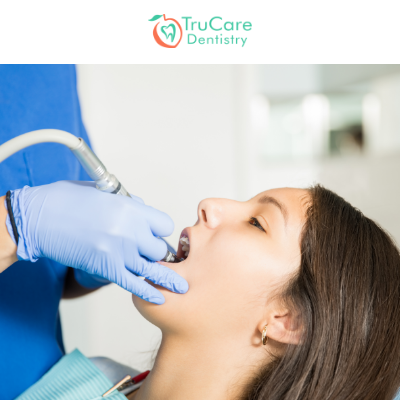
Dental prophylaxis is a preventive measure that entails a routine oral checkup combined with a thorough cleaning by a professional dentist or a dental hygienist.
Dental prophylaxis entails the removal of bacteria, calculus, and buildup of plaque and tartar (mineralized plaque) with the use of specialized devices and instruments to loosen the deposits and remove them from teeth. The procedure includes tooth scaling, polishing, and debridement in case of accumulation of too much tartar.
As per the American Dental Association, regular oral prophylaxis is extremely beneficial to prevent all types of teeth and gum problems. It has designated the CDT code D1110 for adult prophylaxis and the CDT code D1120 for children prophylaxis.
How necessary is dental prophylaxis?
Being a preventive measure and a detailed procedure, dental prophylaxis is extremely necessary. Even if you’re extremely particular about your dental hygiene, you will still need to go for regular dental prophylaxis, which is at least twice a year. Why’s that so? That’s because, despite regular brushing and flossing, you won’t be able to remove the plaque and tartar buildup from inaccessible parts of your teeth.
Apart from that, it’s crucial to find out about dental problems at the earliest. When a cavity or gum disease begins, it does so silently and stealthily. This is where dental prophylaxis can help a person in ascertaining if everything is fine with their teeth and gums or is there any problem.
What happens during dental prophylaxis?
When you go to a dentist for dental prophylaxis, the following things are most likely to happen in the subsequent order.
The dental professional will update your medical history as well as compare it against your records to see if there are any changes in your health. This will help in determining whether or not to examine further. They may also screen for oral cancer.
The dentist will take dental X-rays by using specialized imaging technology to observe the overall health of teeth and bone. Apart from looking for hidden tooth cavities and dental cysts, they can also see the growth of your wisdom teeth and find out if it can cause any complications.
Following that, the dental hygienist will perform a periodontal probing by checking the gaps between teeth and gums as well as tissue depth at the gum line. The gaps and depth will be measured by using specialized tools.
After that, the dentist will perform a thorough dental cleaning by using specialized scraping tools to remove tartar and plaque from your teeth and gum line. They will also remove tooth stains by polishing and performing interdental cleaning. The most common polishing tool is a Prophy Jet, which uses water, air, and a fine powder to polish teeth. They will conclude the procedure with a fluoride mouthwash to strengthen your teeth.
How often should you go for dental prophylaxis?
People with healthy teeth and gums should go for dental prophylaxis once every six months as a preventative measure.
However, people who have dental problems and gum diseases should go for dental prophylaxis once every three or four months. Apart from them, people in the high-risk category should also attend as many sessions. The high-risk people include smokers, diabetics, pregnant women, and immunocompromised people.
1. Benefits of regular dental prophylaxis
When it comes to ensuring your dental health, regular dental prophylaxis comes second to regular brushing and flossing. It has several benefits, some of which are listed below:
2. Removal of plaque and tartar buildup from deep pockets
Despite regular brushing and flossing, tartar and plaque get accumulated in deep gum pockets where the bristles of your toothbrush and the floss thread don’t reach. Regular dental prophylaxis can eliminate months’ worth of buildup in just a few minutes. A professional dentist near you or dental hygienist has all the necessary tools and equipment to do the work.
3. Healthier-looking teeth and fresher breath
The professional cleaning in the dental prophylaxis procedure gets rid of any stains and yellowish tinges on the teeth. The Prophy Jet spray will give a shiny polish to the teeth. After a dental prophylaxis procedure concludes with a fluoride mouthwash, the teeth become stronger and the breath fresher.
Finally, it may be concluded
When it comes to oral hygiene and health, dental prophylaxis is one of the most important procedures. Apart from giving the teeth and gums a thorough cleaning, it finds out if there are any hidden and undetectable problems. At TruCare Dentistry Roswell, GA, we believe prevention is better than cure and we perform comprehensive dental prophylaxis to maintain your best dental health. If you are considering dental prophylaxis in Roswell, GA, then contact us to schedule an appointment today.
FAQs
1. How much does dental prophylaxis cost?
Standard prophylaxis can cost between $75 and $200, depending on the cost of living in a specific area, local fees, as well as the experience and reputation of the dental hygienist.
2. Is prophylaxis the same as dental cleaning? Are prophylaxis and dental cleaning the same?
Even though prophylaxis and regular teeth cleaning are used interchangeably, the former is a more comprehensive process than the latter. Apart from the thorough cleaning, it entails a detailed examination of oral hygiene as well as some intricate tests and inspections.
3. Does a dental prophylaxis procedure remove tartar?
Yes, dental prophylaxis involves thorough cleaning, scaling, scraping, and polishing procedures that remove tartar and bacterial plaque from the mouth.
4. Is prophylaxis a deep cleaning?
Even though prophylaxis is at times referred to as deep cleaning, both are rather different from each other. While the former removes plaque buildup, tartar, and other debris from teeth and mouth, the latter, which is performed as a part of gum disease treatment, cleans at a much deeper level below the gum line to remove all types of buildup.
